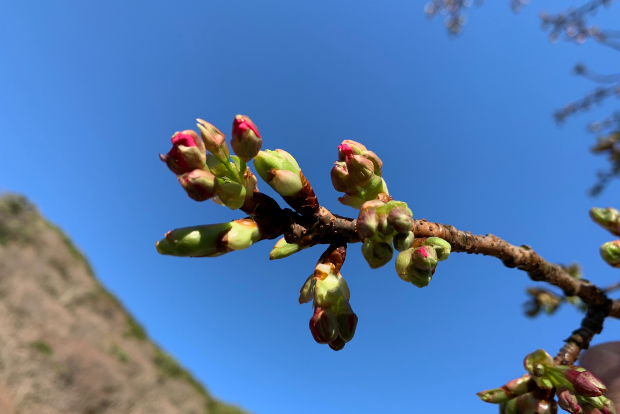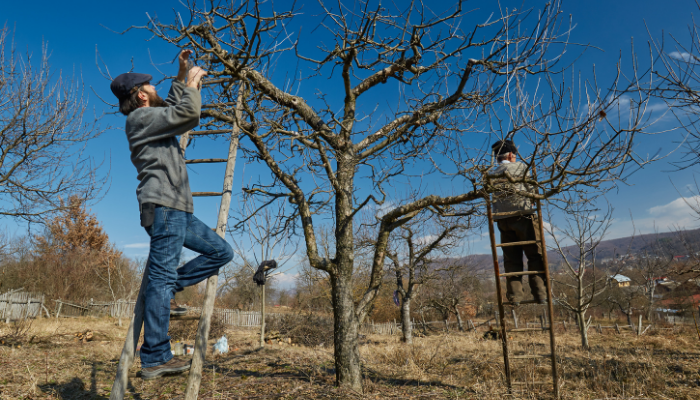Why fruit trees fail to bear

The content of this article 'Why fruit trees fail to bear' was prepared by Linda Naeve and Paul A. Domoto of Iowa State University and has been revised and republished by FreshFruitPortal.com.
Ideally, a fruit tree will begin to bear when it becomes “old enough” to blossom freely. This is not always what happens, however.
The characteristics of the tree, its environment, the cultural practices used, and the weather all affect a tree’s ability to begin and continue to bear fruit.
The key to avoiding poor fruit set is to provide conditions favorable for flower bud formation, survival, and pollination which starts with selecting a good location and then striving to maintain good cultural practices.
Bearing age
Fruit trees purchased from nurseries and garden centers are usually 1- to 2-years-old when they are sold. The length of time from planting to fruit-bearing varies with the species of fruit, the cultivar, and whether the tree is dwarf or standard size (see table).
Differences in bearing age also exist among cultivars. This is particularly true for apples and pears. In general, those cultivars that have an upright growth habit, such as Red Delicious, tend to be tardy coming into bearing, while those with a spreading growth habit, such as Jonathan, tend to be early.
For apples and pears, a cultivar propagated on a dwarfing or semi-dwarfing rootstock will come into bearing at a much earlier age than the same cultivar propagated on a standard-sized rootstock. For the other fruit tree species, neither the genetic dwarfing effect nor the rootstock effect has much of an influence on early bearing capabilities.
Fruit trees may begin to bear earlier than indicated in the table, but caution must be taken to ensure that this fruit does not affect the structure of the tree by pulling limbs downward too far. If premature fruiting does occur, it is advisable to remove fruit located on the upper half of the major limbs.
Flower Bud Formation and Survival
Fruit trees often fail to bear due to either the inability to form flower buds or the failure of the flower buds to develop completely. For all fruit tree species, the flower buds are formed during the growing season prior to time of bloom.
Generally, this occurs between mid-June and mid-July as the vegetative growth begins to slow down. Once the bud begins to form, it continues to develop until flowering the following spring.
Unfavorable conditions before and during this period of development will result in the lack of flower bud formation or the loss of developing buds. Cultural practices and environmental conditions influence whether or not this occurs.
Environmental Factors
Light
Good exposure to sunlight is one of the most important factors influencing the formation of flower buds on fruit trees. Through the process of photosynthesis, the leaves on the tree manufacture sugars used for vegetative growth, flower bud formation, and fruit development.
If sunlight is limited, the tree will continue to grow, but there will not be sufficient sugars for the formation of flower buds. Under such conditions, young trees will be slow coming into bearing, the blossoms will be sparse, and the fruit that forms will be poorly colored.
Dwarf trees also will grow larger than anticipated. For these reasons, fruit trees should be planted in locations where they will receive maximum sunlight. Avoid shaded sites near buildings or other trees.
Water
The lack of sufficient water, as experienced under drought conditions, can have both a positive and a negative influence on the formation of flower buds.
If a temporary drought occurs early in the growing season, during the period of flower bud formation, it can be beneficial in promoting flower buds.
However, if the same drought continued or a prolonged drought developed later in the season, it could result in the loss of flower buds. To prevent such a loss, fruit trees should be watered during periods of prolonged drought, particularly if they are planted near other trees.
Temperature
Low temperatures during winter and spring through bloom can result in the loss of flower buds. During the winter, temperatures below –18°F to –20°F will kill the flower buds of peaches and sweet cherries, while the flower buds of apples, pears, sour cherries, and plums are able to withstand colder temperatures.
However, if the temperature drops severely following a January or February thaw, the killing temperature for flower buds of even the hardiest species is much higher.
The greatest injury to the flower buds occurs when rather warm periods in the early spring are followed by unseasonably cold temperatures. With such warm periods, the buds begin to break dormancy and swell.
As the buds become more active, they become increasingly sensitive to cold temperature and are most sensitive at bloom. Exposed but unopened flowers can usually withstand temperatures near 24°F. However, once opened, the blossoms of nearly all fruit trees will be killed if the temperature drops below 29°F
There is little that can be done to protect flower buds against low winter temperatures other than careful crop and cultivar selection.
For frost protection during bloom, running a sprinkler under a fruit tree is beneficial. Sprinkling a tree is even better, but due to the potential limb breakage, care must be taken to avoid too much ice buildup.
Ice formation around the buds will insulate them from further cold if sprinkling is continued. The practice must begin before the temperature drops below freezing and must continue until the ice formed on the tree begins to melt on its own.
Cultural Practices
Cultural practices that influence the vigor and vitality of the tree will affect its ability to bear fruit early and consistently produce crops.
Poor cultural practices often result in a tree that lacks vigor and vitality. Such trees may start bearing, but fruit production is inconsistent from year to year. These trees are unable to produce enough food reserves to carry a crop, make new growth, and have something left over to form flower buds for the following year. This ultimately leads to biennial bearing.
However, practices that promote excessive vigor will inhibit or delay fruiting. With excessive vigor the manufactured sugars are utilized for vegetative growth and little sugar remains to form flower buds.
One of the easiest ways to judge tree vigor is to observe the amount of shoot growth the tree makes each year. Generally, a tree capable of carrying a crop is judged to have sufficient vigor if the average terminal shoot growth is in the range of 12 to 18 inches.
More vigor is desired with young trees, but as the tree approaches bearing age, cultural practices should be geared toward discouraging excessive vigor.
Fertilization
For young fruit trees in the backyard, overfertilization with nitrogen is one of the major reasons for excessive tree vigor and the lack of fruit. Such trees can easily receive too much nitrogen when the lawn around the tree is fertilized.
For this reason, it is recommended that fruit trees be fertilized well just after planting to encourage good growth. Then, depending on the tree vigor, either withhold or cut back on the nitrogen until the tree begins to bear. This means reducing the rate of nitrogen applied to the lawn around the tree. Once the tree is bearing, normal lawn fertilizer rates should be adequate for most trees.
To fertilize bearing fruit trees independently of the lawn, use a rate of 0.1 lb. of actual nitrogen per inch of the tree trunk diameter at its narrowest point. The fertilizer should be broadcast under the tree.
Observe the amount of terminal shoot the tree makes each year to make adjustments to this recommended rate.
Pruning and Training
Proper training and pruning dictate the potential production of a fruit tree. Fruit trees should be pruned to develop a strong framework and improve light penetration through the tree. Low light intensity is the primary reason for few flowers and poorly colored fruit toward the center of a tree.
As with excessive fertilizer applications, excessive pruning encourages vigorous shoot growth at the expense of flower bud formation. This is particularly true for young nonbearing trees. In order to encourage early fruiting on young trees, pruning should be kept to a minimum and be confined to developing a good framework.
For trees that have begun to fruit, the amount of pruning required each year can be judged by observing the amount of terminal shoot growth. If the average terminal shoot growth is excessive, then less wood should be removed than was taken the previous year. If terminal shoot growth is less than normal and the previous crop was not great, then more wood removal compared to the previous season is warranted.
Fruit Thinning
Bearing fruit trees have the potential of setting more fruit than they are capable of carrying. If all the fruit were left on the tree, they would be small at maturity. More importantly, the tree would have very few, if any, blossoms the following year.
Fruiting is a devitalizing process, and with the competition of a heavy crop, there would be very little manufactured food reserves and nutrients available for flower bud formation. The net result is biennial bearing. To overcome this tendency to bear fruit in alternate years, fruit thinning should be practiced.
Of the types of fruit trees grown in Iowa, apples are the most prone to alternate bearing. If the crop were thinned to one fruit for every three to four spurs, the tree still would have a full crop and good potential for a crop the following year. Fruit thinning should be done within the first month after bloom to ensure this potential.
Pears should be treated the same as apples if there is a heavy crop. Plums will generally thin themselves. Sweet cherries, sour cherries, apricots, and peaches are capable of producing flower buds while carrying a heavy crop. If thinning is practiced on peaches and plums for fruit size, the fruit left should be spaced about 6 to 8 inches apart on the branches.
Pest Management
Insect and disease control often are thought of as means of producing quality fruit. However, insects or diseases that attack the foliage of a fruit tree can affect its potential to produce flower buds. If the attack is severe enough, the trees may fail to bear. Timely applications of recommended pesticides will control most pest problems on fruit trees.
Pollination
All the precautions to ensure the production of flower buds may be taken, but without proper pollination, trees will still fail to bear. Many fruit species or cultivars within a species either cannot produce fruit or will produce very little when pollinated with their own pollen.
Such trees require pollen from another cultivar of the same species to be fruitful. This is true for apples, pears, hybrid plums, and sweet cherries. Most peaches, sour cherries, and apricots are capable of setting good crops without cross-pollination.
Insects, particularly honey bees, are necessary to transfer pollen from one flower to another. If the weather is either cold, rainy, or very windy during bloom, bee activity will be reduced, which will, in turn, reduce fruit set.
Source: Iowa State University









































